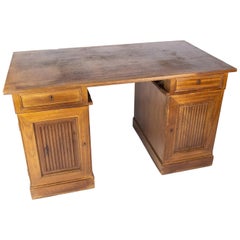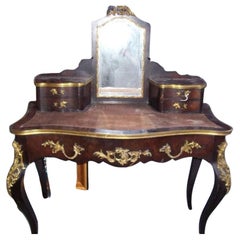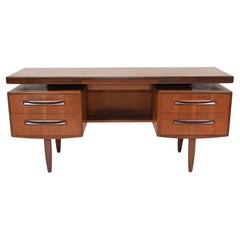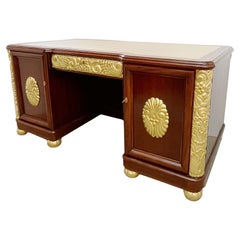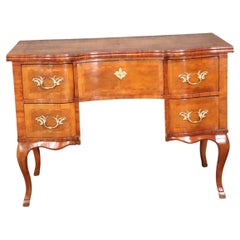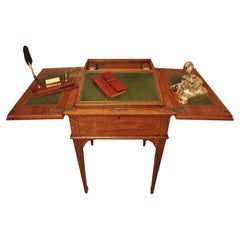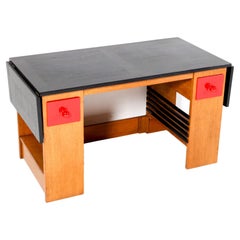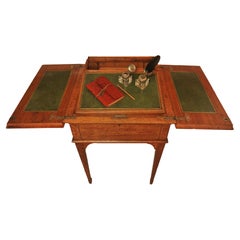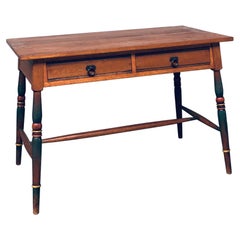1920s Writing Desk
Vintage 1920s Danish Other Desks and Writing Tables
Mahogany
Early 20th Century French Desks and Writing Tables
Mahogany
Vintage 1920s Art Deco Desks and Writing Tables
Wood
Vintage 1920s French Art Deco Desks and Writing Tables
Gold Leaf
Vintage 1920s European Louis XV Desks and Writing Tables
Walnut
Vintage 1920s English Edwardian Desks and Writing Tables
Leather, Mahogany, Oak
Vintage 1920s Dutch Art Deco Desks and Writing Tables
Oak
Vintage 1920s English Edwardian Desks and Writing Tables
Mahogany, Leather, Oak
Vintage 1920s Dutch Arts and Crafts Desks and Writing Tables
Oak
Vintage 1920s Czech Art Deco Desks and Writing Tables
Lacquer, Wood, Mahogany, Walnut
Early 20th Century Spanish Country Desks and Writing Tables
Pine
Vintage 1910s Lebanese Desks and Writing Tables
Cedar
Early 20th Century Danish Brutalist Desks and Writing Tables
Oak
Vintage 1920s Italian Art Deco Desks and Writing Tables
Parchment Paper
Vintage 1920s English Desks and Writing Tables
Oak
20th Century Desks and Writing Tables
Walnut
Early 20th Century English Desks and Writing Tables
Brass
Vintage 1920s Italian Desks and Writing Tables
Wood
Vintage 1920s Dutch Art Deco Desks and Writing Tables
Oak
Vintage 1920s Dutch Art Deco Desks and Writing Tables
Oak
Early 20th Century French Art Deco Desks and Writing Tables
Stainless Steel
Vintage 1920s French Art Deco Desks and Writing Tables
Wood
Vintage 1920s Italian Mid-Century Modern Desks and Writing Tables
Brass
Vintage 1920s Dutch Art Deco Desks and Writing Tables
Faux Leather, Macassar, Oak
Early 20th Century Victorian Desks and Writing Tables
Mahogany
Early 20th Century North American Desks and Writing Tables
Wood
Vintage 1920s French Art Nouveau Desks and Writing Tables
Wood
Early 20th Century American American Colonial Desks and Writing Tables
Hardwood, Oak
Vintage 1920s Italian Desks and Writing Tables
Walnut
Early 20th Century Lebanese Moorish Desks
Wood, Cedar
Early 20th Century French Art Deco Desks
Walnut
Vintage 1920s German Renaissance Desks and Writing Tables
Walnut
Vintage 1920s North American Chinoiserie Desks and Writing Tables
Wood
Vintage 1920s Czech Art Deco Desks and Writing Tables
Wood
Vintage 1920s American Industrial Desks and Writing Tables
Brass
Vintage 1920s Art Deco Desks and Writing Tables
Birch
Vintage 1920s German Desks and Writing Tables
Fir
Vintage 1920s Desks and Writing Tables
Oak
Vintage 1920s American American Craftsman Desks and Writing Tables
Oak
Vintage 1920s Hungarian Art Nouveau Desks and Writing Tables
Beech
Vintage 1920s American Industrial Desks and Writing Tables
Metal
Early 20th Century French Other Desks and Writing Tables
Wood
Vintage 1920s French Art Deco Desks and Writing Tables
Chrome
Early 20th Century Unknown Desks and Writing Tables
Wood
Vintage 1920s Swedish Desks and Writing Tables
Early 20th Century English Desks and Writing Tables
Early 20th Century Swedish Edwardian Desks and Writing Tables
Mahogany
Vintage 1920s Desks and Writing Tables
Chrome
Early 20th Century Swedish Art Deco Desks and Writing Tables
Birch
Early 20th Century Swedish Edwardian Desks and Writing Tables
Mahogany
Vintage 1920s French French Provincial Desks and Writing Tables
Pine, Paint
Early 20th Century French Desks and Writing Tables
Marble
Early 20th Century Desks and Writing Tables
Cardboard
Vintage 1910s English Edwardian Desks and Writing Tables
Mahogany
Vintage 1920s European Art Nouveau Desks and Writing Tables
Wood
Vintage 1920s European Art Deco Desks and Writing Tables
Wood
Early 20th Century Danish Desks and Writing Tables
Oak, Paint
- 1
1920s Writing Desk For Sale on 1stDibs
How Much is a 1920s Writing Desk?
Finding the Right Desks-writing-tables for You
Choosing the perfect writing desk or writing table is a profoundly personal journey, one that people have been embarking upon for centuries.
Queen Atossa of Persia, from her writing table circa 500 B.C., is said to have been the originator of the art of handwritten letters. Hers was reportedly the first in a long and colorful history of penned correspondence that grew in popularity alongside literacy. The demand for suitable writing desks, which would serve the composer of the letters as well as ensure the comfort of the recipient naturally followed, and the design of these necessary furnishings has evolved throughout history.
Once people began to seek freedom from the outwardly ornate styles of the walnut and rosewood writing desks and drafting tables introduced in the name of Queen Victoria and King Louis XV, radical shifts occurred, such as those that materialized during the Art Nouveau period, when designers longed to produce furniture inspired by the natural world’s beauty. A prime example is the work of the famous late-19th-century Spanish architect Antoni Gaudí — his rolltop desk featured deep side drawers and was adorned with carved motifs that paid tribute to nature. Gaudí regularly combined structural precision with decorative elements, creating beautiful pieces of furniture in wood and metal.
Soon afterward, preferences for sleek, geometric, stylized forms in furniture that saw an emphasis on natural wood grains and traditional craftsmanship took hold. Today, Art Deco desks are still favored by designers who seek to infuse interiors with an air of luxury. One of the most prominent figures of the Art Deco movement was French decorator and furniture designer Émile-Jacques Ruhlmann. With his use of neoclassical motifs as well as expensive and exotic materials such as imported dark woods and inlays of precious metals for his writing desks, Ruhlmann came to symbolize good taste and modernity.
The rise in appreciation for Scandinavian modernism continues to influence the design of contemporary writing desks. It employs the “no fuss” or “less is more” approach to creating a tasteful, sophisticated space. Sweden’s master cabinetmaker Bruno Mathsson created gallery-worthy designs that are as functional as they are beautiful. Finnish architect Alvar Aalto never viewed himself as an artist, but, like Mathsson, his furniture designs reflected a fondness for organic materials and a humanistic approach. Danish designers such as Hans Wegner introduced elegant shapes and lines to mid-century desks and writing tables, often working in oak and solid teak.
From vintage desks to contemporary styles, 1stDibs offers a broad spectrum of choices for conducting all personal and business writing and reading activities.
- What is a writing desk?1 Answer1stDibs ExpertSeptember 25, 2019
A writing desk may refer to a desk with a top, often sloping, for writing on or to a portable case with compartments to hold writing materials and a surface for writing.
- 1stDibs ExpertOctober 12, 2021A small writing table is also called a davenport table or davenport desk. They normally feature a sloped or inclined top attached with hinges to the back of the table. On 1stDibs, find a variety of antique and vintage davenport desks.
- 1stDibs ExpertOctober 19, 2021A writing desk with drawers is also called a secretary. It is a desk with drawers, one of which can be pushed out and the front of the desk lowered to create a flat writing surface. These writing desks have been made in a variety of styles over the years. Shop for a variety of writing tables with drawers on 1stDibs.
- What do I wear to a 1920s party?1 Answer1stDibs ExpertMarch 3, 2023To a 1920s party, you can wear a short fringed or beaded flapper dress, layers of long beaded or pearl necklaces, elbow-length gloves and a feathered headband. Another option is to wear an off-white men's suit. Shop a selection of vintage apparel on 1stDibs.
- 1stDibs ExpertMarch 22, 2022In the 1920s, flappers often wore straight, fitted dresses with plunging necklines and knee-length hems. Fringe was a common embellishment used at the time. Flappers also sported pumps and opted for bras and lingerie instead of corsets for undergarments. Shop a variety of vintage clothing on 1stDibs.
- What is 1920s furniture called?1 Answer1stDibs ExpertNovember 13, 2024What 1920s furniture is called depends on its style. However, the most prominent design style of the decade was Art Deco. The term alone conjures visions of the Roaring Twenties, Machine Age metropolises, vast ocean liners, sleek typography and Prohibition-era hedonism. The iconic movement made an indelible mark on all fields of design throughout the 1920s and ’30s, celebrating society’s growing industrialization with refined elegance and stunning craftsmanship. Art Deco furniture often featured bold geometric lines, floral forms, shimmering mirrored finishes, sleek metal accents, and the use of expensive materials such as shagreen or marble as well as exotic woods such as mahogany, ebony and zebra wood. On 1stDibs, find a diverse assortment of Art Deco furniture.
- 1stDibs ExpertJune 15, 2023In the 1920s, fashionable colors included jewel tones. Fashion, jewelry, furniture and decorative objects often featured jade green, deep reds, amethyst purple, dusty mustard yellow and peacock blue. Find a range of 1920s-era jewelry and fashion on 1stDibs.
- 1stDibs ExpertMay 5, 2023In the 1920s, brides often wore tubular-shaped slip dresses with a beaded tunic over top. Hemlines usually fell just below the knee or to the ankle, and many gowns had dropped waists. For headwear, brides often showed off veils attached to cloche or flapper-style headbands. On 1stDibs, shop a collection of wedding dresses from some of the world’s top boutiques.
- 1stDibs ExpertApril 5, 2024The clothing style in the 1920s that most people think of first is the flapper style. Women who dressed in this style sported loose-fitting, short dresses, often outfitted with drop waists and fringe. Small cloche hats and headbands were signature accessories of the flapper look. During the decade, pleated tennis skirts and cardigan sweater sets left the courts and became staples of some women's everyday styles. For men, soft collars replaced stiff, starched ones, and simple single and double-button suit jackets worn without waistcoats became trendy. Trousers also took on a new shape with wider-cut legs, and Oxford bags gained popularity. On 1stDibs, shop a variety of 1920s apparel and accessories.
- What are 1920s dresses called?1 Answer1stDibs ExpertFebruary 13, 2023The iconic dresses from the 1920s are called flapper dresses. This name comes from the term flapper, which was used to describe young women during the period who enjoyed personal fulfillment and independence in American cities, particularly as they gained the right to vote and enjoy other freedoms previously reserved for men. Flappers danced at jazz clubs and upended most societal restrictions placed on women at the time, and fashion statements typically attributed to flappers included short “bob” haircuts, higher hemlines and other then-audacious style choices. Find a selection of flapper dresses on 1stDibs.
- What era is 1920s jewelry?1 Answer1stDibs ExpertDecember 4, 2023What era 1920s jewelry is depends on its design. Most people associate this decade with the Art Deco movement, which took inspiration from eclectic sources like Cubism, ancient Egypt and Native American, African and Asian motifs. However, some pieces produced during the 1920s are more in line with the style trends of earlier periods, such as Art Nouveau, Edwardian and Victorian. Explore a diverse assortment of 1920s jewelry on 1stDibs.
- 1stDibs ExpertJune 15, 2023What an old-fashioned writing desk is called varies by design. Pieces with drop-down fronts are secretary desks (these are typically made of two parts: a chest of drawers on the bottom and a hutch or cupboard with shelves on the top), while ones that rest on two pillars, cabinets or bookcases are pedestal desks. A desk with a small writing surface positioned in front of drawers and cubbies is a bureau à gradin. On 1stDibs, shop a selection of desks.
- 1stDibs ExpertMay 5, 2023The type of tile that was used in the 1920s was primarily ceramic. Many shapes were available, including basketweave, penny round, pinwheel, square and subway. Hexagon tiles, however, which are still on trend, have been in use in bathrooms since at least the early 1900s. The choice of hexagonal tiles is believed to have been tied to cleanliness, as the small pieces could stand up to aggressive cleaning and could be easily replaced if needed. On 1stDibs, shop a collection of tiles from some of the world's top sellers.
- 1stDibs ExpertApril 5, 2022Flapper dresses from the 1920s came in a range of colors, although darker hues such as black and navy were immensely popular. Flapper dresses were cut with straight and slim silhouettes, were typically knee-length and had a lower neckline. They were often made from silk chiffon and featured beaded details. You’ll find a selection of 1920s flapper dresses from some of the world’s top sellers on 1stDibs.
- 1stDibs ExpertMarch 3, 2023In French, the term for a writing desk that often featured a drop-down writing surface is secretaire. This type of desk is called a secretary desk in English. Simply put, a secretary desk is a multifunctional piece of furniture with a hinged writing surface that folds open or drops down. When the leaf is folded out, small inner storage compartments, which are called pigeonholes, cubbies, recesses or drawers, are revealed. On 1stDibs, shop antique secretary desks from some of the world's top sellers.
- 1stDibs ExpertNovember 21, 2023In the 1920s, engagement rings still looked like rings but were representative of a diverse range of styles and influences. Art Deco diamond ring designs took inspiration from the contemporary Cubist movement as well as from ancient Egypt – a revival sparked by the opening of King Tut’s tomb in 1922. Native American, African and Asian motifs also inspired jewelry pieces. Diamonds in square and rectangular shapes incorporating angular steps – like emerald cuts, Asscher cuts and baguettes – were set against black onyx, rubies, sapphires and emeralds to create color-blocking effects. Platinum, 18-karat gold, 14-karat white gold and sterling silver were some of the favored metals of the decade. Find a wide range of Art Deco engagement rings on 1stDibs.
- 1stDibs ExpertJanuary 10, 2025Coco Chanel was considered one of the leading fashion designers in the 1920s and ’30s in Paris. The first Chanel shop was established in 1910 on rue Cambon by the young milliner Gabrielle Chanel, who had picked up the nickname “Coco” while working as a club singer. The boutique drew the attention of the Parisian fashion elite, who popularized her wide-brimmed Chanel Modes hats. Soon, she added a sportswear store in the Normandy resort town of Deauville, where Coco set the tone for her defining sense of style — traditionally masculine garments reimagined for feminine shapes, made from simple jersey fabric. Effortless and elegant, Chanel's designs promoted comfort and grace in women’s wear that had been dominated in the previous century by complicated layers of fabric and cumbersome corsets. She followed this success with a couture house, opened in 1915 in Biarritz. In 1926, Chanel introduced her first little black dress, reclaiming a color that had once been reserved for mourning and working-class women. That same decade, she debuted her perfume, Chanel No. 5, as well as the Chanel suit with a fitted skirt, inspired by the boxy lines of men’s clothing and employing a sporty tweed. During the 1920s, she also unveiled the predecessor for the 2.55 Flap bag, which remains one of Chanel's most popular offerings. Shop a large selection of Chanel apparel, bags and accessories on 1stDibs.
Read More
20 Inviting Dining Rooms Perfectly Arranged for Entertaining
Top interior designers show — and tell — us how to create delectable spaces for hosting dinner parties.
This Alain Delon–Designed Table Is Almost as Handsome as He Was
Fans of the French film star may be surprised to learn that he had a flair for furniture with sleek lines and disco-era flash.
Uchronia’s Plant Stand Gives Pots a Pretty Perch with All the Trimmings
Like other pieces in the firm’s Candy Box collection, the cheerful limited-edition design showcases French craft.
The Ultimate Guide to Types of Tables for the Home
Whether you’re just moving in or ready to give your home a makeover, our guide will give you pointers on tables that are fitting for every room, nook and hallway.
Is Lionel Jadot the Willy Wonka of Upcycled Belgian Design?
From his massive collaborative workshop in a former paper factory, the designer concocts funky furniture from disused materials, as well as luxe hotel interiors like the new Mix Brussels.
Inspired by the Cosmos, Sandra Nunnerley’s Nova Table Has a Futuristic Feel
The designer’s innovative use of an unexpected material gives this console a lift.
This 19th-Century Gilded Desk Displays a Fanciful Kingdom in Marquetry
The stately piece brings both gravitas and whimsy to any work space.
In Guadalajara, These Luscious Side Tables Are Chiseled from Volcanic Rock
Use them as tables or stools, indoors or out.
